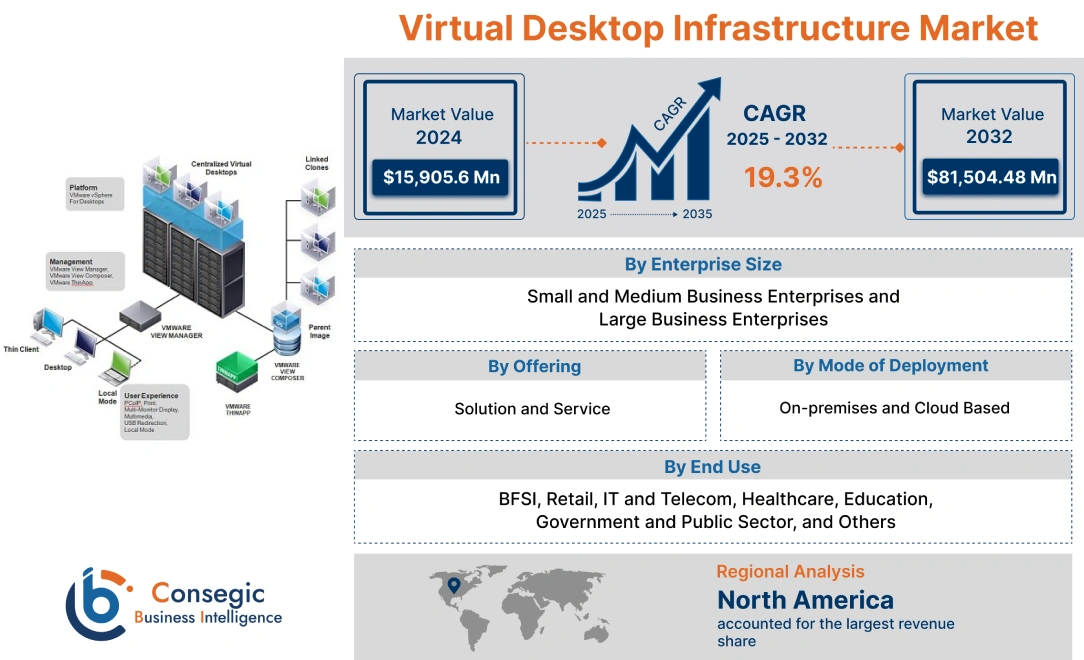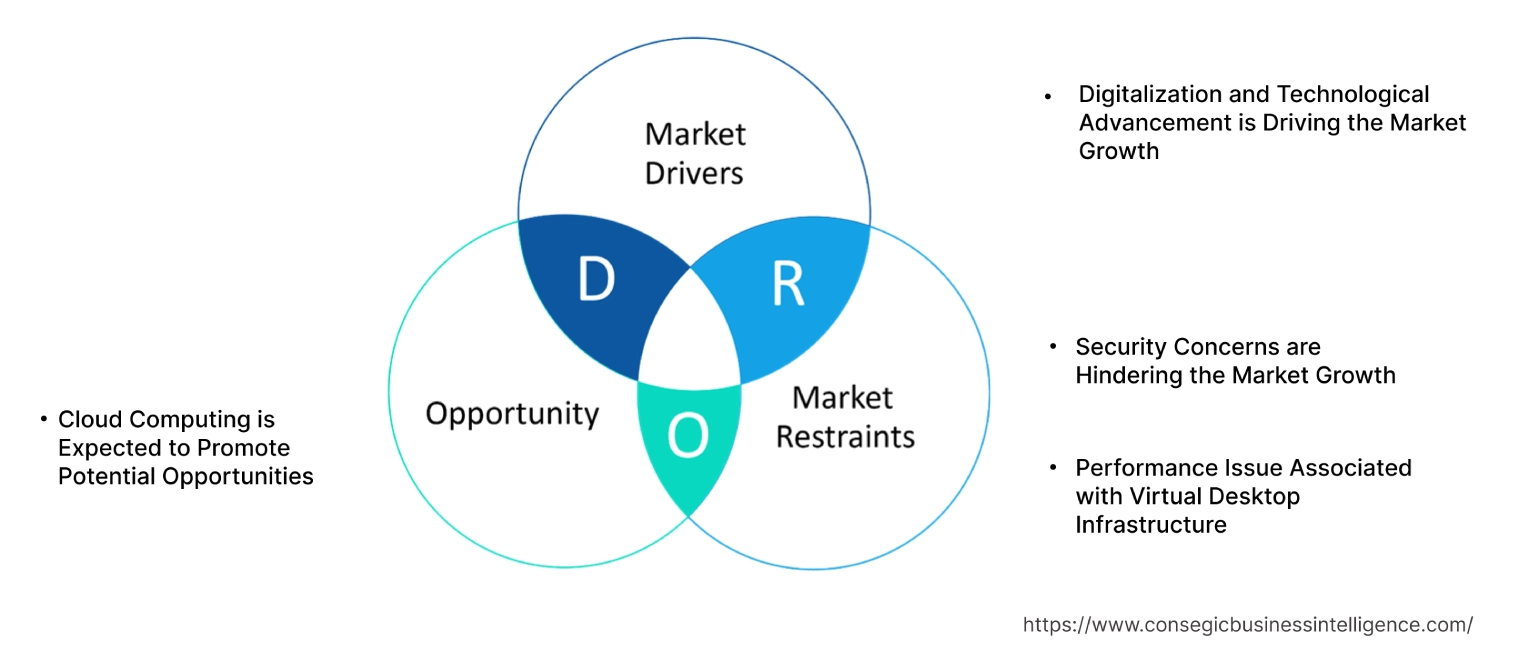- Summary
- Table Of Content
- Methodology
Virtual Desktop Infrastructure Market Size:
Virtual Desktop Infrastructure Market size is estimated to reach over USD 81,504.48 Million by 2032 from a value of USD 15,905.60 Million in 2024 and is projected to grow by USD 19,226.40 Million in 2025, growing at a CAGR of 22.70% from 2025 to 2032.
Virtual Desktop Infrastructure Market Scope & Overview:
Virtual Desktop Infrastructure refers to a technology setup where a desktop is stored on a central server. This provides a kind of desktop virtualization where the operating system runs within a virtual machine and is delivered over a network to the client. It is versatile and can be used for managing virtual desktops accessible from any device, including personal computers, smartphones, or tablets. This eliminates the need for companies to provide, manage, repair, and replace physical machines. Moreover, it offers a range of benefits including flexibility, accessibility, and cost-effectiveness.
Virtual Desktop Infrastructure Market Insights:
Key Drivers:
Digitalization and Technological Advancement is Driving the Market Growth
Growing companies are turning to digital solutions to improve performance and, as a result, there is a huge surge in the need for safe and efficient remote work setups. Digital transformation is supported substantially by VDI technology because it gathers all desktop environments together into a protected data center when enabled. It provides seamless remote access from any device, enhancing performance, security, and scalability.
Moreover, advances in technology have made these solutions more user-friendly and efficient. Further, they have reduced the burden on IT teams hence making VDI appealing to businesses.
- For instance, in August 2023, VMware included AI in its Anywhere Workspace suite under the VMware Cross-Cloud Services for employee experience enhancement, vulnerability management, and streamlining app lifecycle management. This platform blends digital employee experience or DEX, desktop as a service also known as DaaS, and virtual desktop infrastructure abbreviated as VDI, unified endpoint management or UEM, and safety in one package which offers people a chance to work from anywhere without worrying about security.
Thus, the combination of digitalization and technological progress is indeed fueling the virtual desktop infrastructure market growth.
Key Restraints :
Security Concerns are Hindering the Market Growth
VDI involves centralizing desktop environments and providing remote access from any device on a secure server; thus, it is fraught with potential security threats. These may be data breaches, unauthorized access, or cyber-attacks. Moreover, Even though these solutions include sophisticated security measures, the fear of such threats often hinders organizations from embracing VDI. It's crucial for VDI providers to continuously enhance their security features and build robust protocols to alleviate these concerns and foster trust among potential users. This will not only mitigate the security risks but also contribute to the growth and adoption of VDI in the long run.
- For instance, in October 2020, according to Morphisec Ltd., VDI had special security issues such as effective resource allocation and probable boot storms caused by updating the antivirus. Despite this threat, solutions with moving target defense technology promise a good way out of the situation in terms of VDI security through anticipatory attack blocking and the provision of effective protection of every single virtual instance.
Thus, the virtual desktop infrastructure market analysis shows that the security concerns associated with these technologies obstruct the market.
Performance Issue Associated with Virtual Desktop Infrastructure
During peak usage times, network congestion or a lack of adequate resources can lead to high latency and slow response times. Virtual desktop streaming may also cause lag or latency that affects real-time performance for the users. User experience can be affected when graphic rendering causes visual distortion. Additionally, a range of things like real-time antivirus scanning, disk fragmentation, outdated virtual clients as well as minimal hardware requirements for VM software contribute to connectivity issues. On the other hand, even though there are instances in which IT administrators provision too many resources to cater for delays in application requests and increase the speed of processing, sometimes this results in wastage instead of helping with a performance boost.
- For instance, in June 2023, according to Venn, when using a virtual desktop to assist real-time activities like video conferencing or document editing, network latency can swiftly emerge, resulting in choppy video or delay in keyboard typing. Many users say their VDI Desktop is either very slow or sometimes does not work at all. Delays up to 300ms can cause noticeable lag in keyboard strokes and mouse movement, and degrade video quality. An RTT over 300ms is not recommended for a stable VDI connection and can lead to user complaints.
Future Opportunities :
Cloud Computing is Expected to Promote Potential Opportunities
Since the resources of cloud-based VDI can be easily expanded or reduced depending on different workloads, it has been able to dominate the VDI market. The increase in cloud-based VDI especially among small and medium-sized enterprises (SMEs) is now being influenced by the simplicity with which virtual infrastructure can be handled such that one does not require any expertise.
- For instance, in January 2024, Workspot secured a significant new account with Siemens Energy. Siemens Energy chose Workspot's VDI platform and Google Cloud to provide their globally distributed workforce with reliable and high-performance access to virtual apps and desktops.
Thus, the market trends analysis shows that integration of cloud computing with VDI will boost the virtual desktop infrastructure market opportunities.
Virtual Desktop Infrastructure Market Segmental Analysis :
By Type:
Based on the type, the market is trifurcated into virtual desktop infrastructure, desktop-as-a-service, and remote desktop services.
The virtual desktop infrastructure segment accounted for the largest revenue of 57.29% in 2023 and the segment is anticipated to register a significant CAGR during the forecast period.
- Factors affecting the segment include the increasing demand for cloud solutions, the need for virtualization, the adoption of remote working solutions, and others.
- Moreover, it offers a range of benefits including flexibility, accessibility, and cost-effectiveness.
- For instance, in September 2023, Sangfor unveiled the latest 5.9.0 version of its VDI, themed The Road to Convergence, marking significant advancements. Sangfor has become the pioneer in the industry due to the tight integration of VDI and security parts in this version, thereby enhancing the safety of virtual desktops alongside their data.
- Thus, as per the segmental trends analysis, the aforementioned factors drive the virtual desktop infrastructure market share.
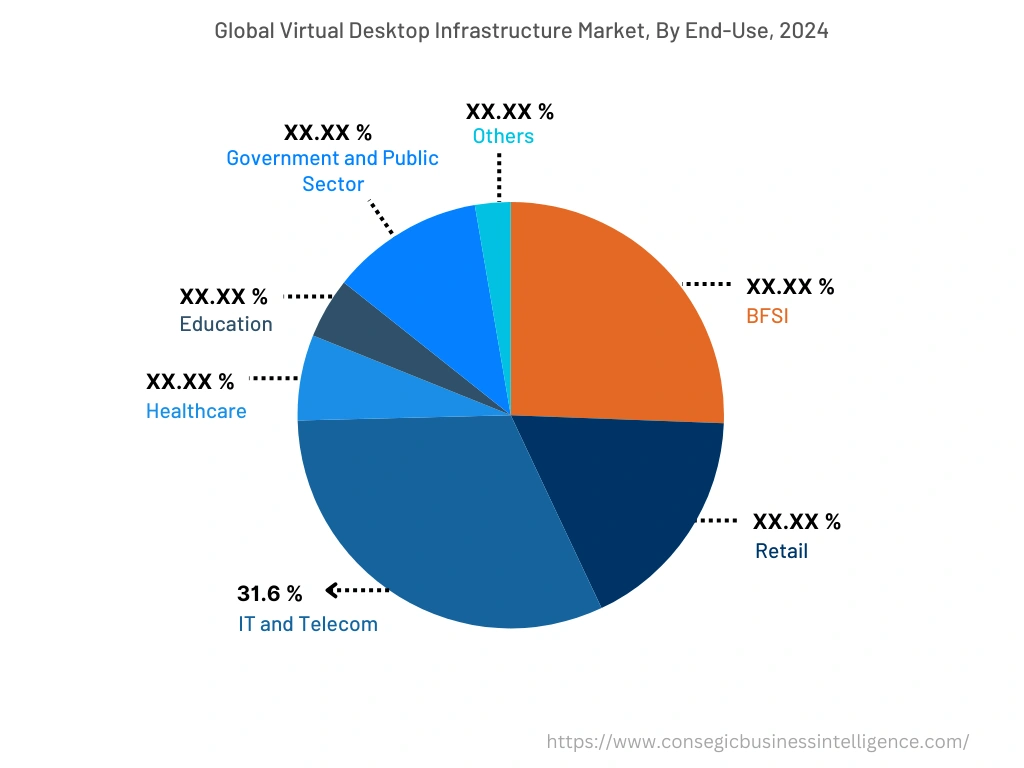
By Offering:
Based on the offering, the market is bifurcated into solutions and services.
The solution segment accounted for the largest revenue share in 2024.
- Factors affecting the solution segment include the growing need for specialized professional services and the increasing complexity of VDI deployments.
- Moreover, these solutions offer a range of benefits including improved system efficiency, reduced downtime, and enhanced security.
- For instance, in May 2024, Dizzion is aware of the challenges and possibilities in highly regulated fields. The Dizzion customizable platform can improve the quality of service for customers shared with IBM, help roll out new features such as Managed DaaS as well as Compliance Services (PCI, HIPAA, SOC, and GDPR), and allow them more flexibility in their Dizzion virtual desktops delivery on IBM Cloud so that they are as per performance and regulatory standards.
- Hence, the solutions provided enhance the efficiency and security driving the market.
The service segment is anticipated to register a significant CAGR during the forecast period.
- Factors affecting the segment include the complexity of VDI deployments and the need for regular maintenance and updates.
- Moreover, the primary benefits of service include enhanced system efficiency, reduced downtime, improved security, and continuous support.
- For instance, in November 2023, Anunta launched its DaaS Partner Program to enable resellers and service providers to tap into the burgeoning DaaS market. The program aids in scaling their DaaS business, meeting customer needs, and enhancing their revenue potential. It offers three partnership types - alliance, reseller, and referral - aligning with their business objectives.
- Thus, as more enterprises prefer services offered by the providers, this is expected to drive the virtual desktop infrastructure market trends.
By Deployment:
Based on the deployment, the market is bifurcated into on-premise and cloud.
The cloud segment accounted for the largest revenue share in the year 2024 and the segment is anticipated to register a significant CAGR during the forecast period.
- Factors affecting the cloud segment include lower cost compared to on-premise solutions, strong network connectivity, and the focus of cloud-based VDI vendors on developing high-level security patches.
- Moreover, the cloud offers a range of benefits including reduced endpoint footprint, feature-rich apps, better user experiences, and increased business agility, responsiveness, and flexibility.
- For instance, in April 2024, Cloud Software Group, Inc., and Microsoft Corp. announced an eight-year strategic partnership to enhance their collaboration. The arrangement has been made to boost the market entry strategy of the Citrix virtual application and desktop platform as well as enable the development of new cloud and AI solutions that will follow a unified product roadmap. Another thing is that Cloud Software Group will invest $1.65 billion in Microsoft's generative AI capabilities running on its cloud platform.
- Thus, cloud deployment is widely used in comparison with on-premise deployment, driving the virtual desktop infrastructure market growth.
By Enterprise:
Based on the enterprise, the market is bifurcated into small and medium business enterprises and large business enterprises.
The small and medium business enterprise segment accounted for the largest revenue in the year 2024.
- Factors affecting the small and medium business enterprise segment include growing demand for cloud solutions, the need for virtualization, the adoption of remote working solutions, and the shift to a remote-first culture.
- Moreover, VDI offers a range of benefits including enhanced security through centralized management and control of desktop environments, reducing the risk of data loss, malware infections, and unauthorized access to these enterprises.
- It also provides flexibility and mobility, allowing employees to access their desktops and applications from any internet-connected device.
- For instance, in February 2023, Nerdio and ControlUp combined the ControlUp Real-Time DX DaaS monitoring with Nerdio Manager for the Enterprise platform. This platform improves Azure Virtual Desktop, Windows 365, and Microsoft Intune by making management easier, operations more effective, and cutting down Azure compute and storage costs by 80%. ControlUp Real-Time DX is designed to give real-time metrics that allow IT experts to preventatively fix issues that may lower employees' digital experience as well as productivity.
- Thus, small and medium enterprises are dependent on this technology for remote work solutions along with other benefits, hence driving the virtual desktop infrastructure market share.
The large business enterprise segment is anticipated to register a significant CAGR during the forecast period.
- Factors affecting the large business enterprise segment include the need for efficient resource management, the need for secure remote access to desktops, and the requirement for high-performance virtual environments.
- Moreover, the primary benefits for large business enterprises include scalability, enhanced security, cost-effectiveness, and improved productivity.
- For instance, in October 2021, according to Wipro, Virtual Desktop Infrastructure (VDI) provides a virtual environment where business applications and data are accessible to end-user devices from centralized data centers, either on-premise or cloud-based. VDI offers numerous advantages, including centralized management of image deployment, policy and patch management, and application portability. Furthermore, it enables HR and recruitment teams to hire globally, saves on real estate costs, reduces commuting time, and improves productivity.
- Thus, the analysis of segmental trends depicts that large enterprises use the technology for scalability and efficiency, hence driving the virtual desktop infrastructure market opportunities.
By End Use:
Based on the end use, the market is segregated into BFSI, retail, IT and telecom, healthcare, education, government and public sector, and others.
The BFSI segment accounted for the largest revenue share in 2024.
- Factors including the need for secure and efficient data management, the increasing adoption of digital banking solutions, and the need for improved customer service are key aspects driving the BFSI segment.
- For instance, the Swiss bank selected Wipro to facilitate their large-scale transition to remote work environments. Specifically, Wipro's virtues, a VDI services solution, allowed employees to operate from virtually any location, ensuring uninterrupted banking services for customers. Wipro's Rapid Employee Access Solution connected employees to bank systems, scaled to meet increasing connection needs, provided top-notch security, and optimized performance.
- Thus, as per the segmental trends analysis, the wide applications of virtual desktop technology in the BFSI sector are driving the virtual desktop infrastructure market demand.
The healthcare segment is expected to witness a significant CAGR during the forecast period.
- The growth of the healthcare segment is attributed to several factors including the increasing need for efficient patient data management, the adoption of telemedicine and remote patient monitoring systems.
- Moreover, the demand for secure and compliant data handling and digital transformation initiatives in the healthcare industry also drive the market.
- For instance, in November 2023, as per the analysis of V2Cloud Solutions, Inc., VDI plays a crucial role in healthcare compliance by safeguarding sensitive patient information. It centralizes data on secure servers, eliminating the risk of data vulnerability on individual devices. VDI offers enhanced security by employing robust encryption, multi-factor authentication, and secure data transmission protocols, ensuring HIPAA compliance and patient confidentiality.
- Thus, the rising applications of VDI technology in the healthcare sector drive the virtual desktop infrastructure market trends.
Regional Analysis:
The regional segment includes North America, Europe, Asia Pacific, the Middle East and Africa, and Latin America.
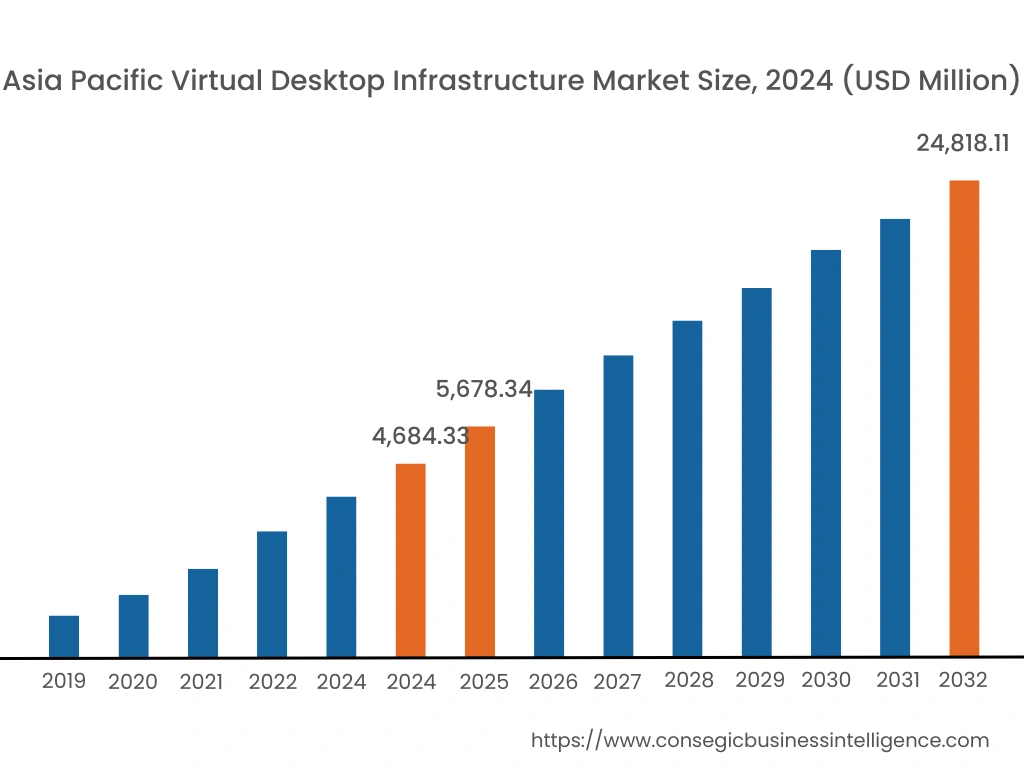
Asia Pacific region was valued at USD 4,684.33 Million in 2024. Moreover, it is projected to grow by USD 5,678.34 Million in 2025 and reach over USD 24,818.11 Million by 2032. Out of this, China accounted for the maximum revenue share of 33.9%. As per the virtual desktop infrastructure market analysis, the growth in the Asia Pacific is primarily driven by the prevalence of the increasing digitization of business operations in the region including rising demand for cloud-based computing solutions. Moreover, the investments in cloud computing and digital transformation initiatives, as well as the rising usage of smart devices and the increase in mobile workforce have been a prevalent factor for virtual desktop infrastructure market expansion in the region.
- For instance, in March 2021, Citrix acquired Wrike, a work management platform to escalate its delivered SaaS solutions over the cloud and quicken its roadmap for the next era of work.
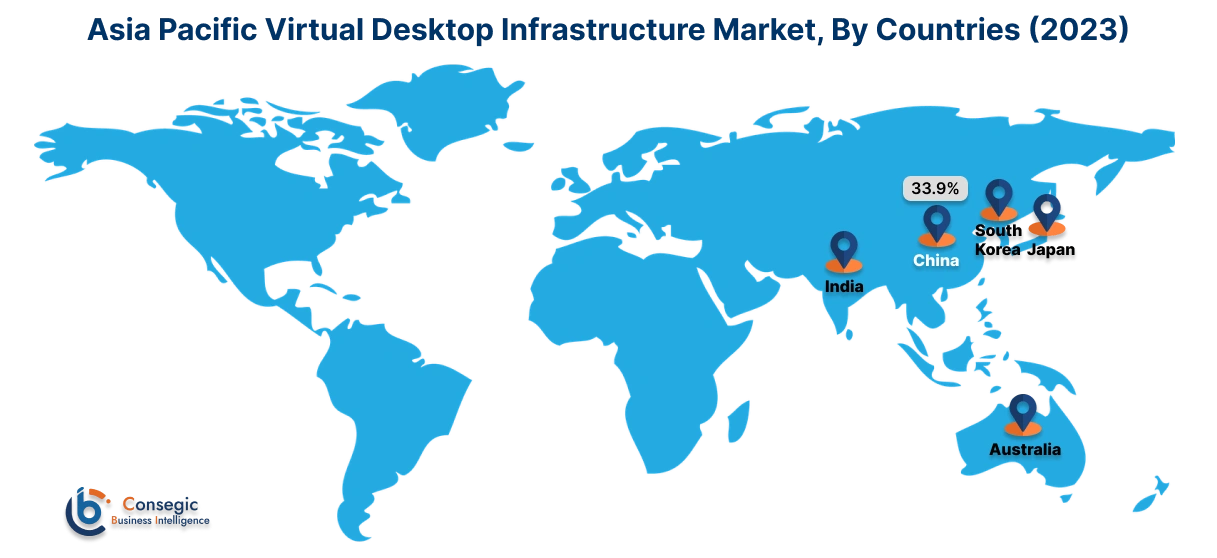
North America is estimated to reach over USD 26,415.60 Million by 2032 from a value of USD 5,276.02 Million in 2024 and is projected to grow by USD 6,365.37 Million in 2025. The increasing adoption of cloud-based solutions is providing lucrative growth prospects for the market in the region. In addition, factors including a surge in remote working trends and the escalating demand for data security are driving the virtual desktop infrastructure market expansion in the North American region.
- For instance, in January 2022, according to TIBCO, Citrix is set to merge with TIBCO Software to form a global leader in digital workspace and data analytics. Citrix Systems, Inc. has announced a definitive agreement for its acquisition by Vista Equity Partners and Evergreen Coast Capital Corporation, an affiliate of Elliott Investment Management L.P., in an all-cash transaction valued at $16.5 billion, including Citrix's debt.
Top Key Players & Market Share Insights:
The virtual desktop infrastructure market is highly competitive with major players providing products and services to the national and international markets. Key players are adopting several strategies in research and development (R&D), product innovation, and end-use launches to hold a strong position in the global virtual desktop infrastructure market. Key players in the virtual desktop infrastructure industry include-
- Microsoft Corporation (United States)
- Amazon.com, Inc. (United States)
- Citrix Systems, Inc. (United States)
- International Business Machines Corporation (IBM) (United States)
- Ericom Software, Inc. (United States)
- Parallels International GmbH (Germany)
- Wipro Limited (India)
- VMware, Inc. (United States)
- V2 Cloud Solutions, Inc. (Canada)
- Nutanix, Inc. (United States)
Recent Industry Developments :
- In April 2024, Scale Computing launched a campaign to promote its Virtual Desktop Infrastructure (VDI) technology. VDI technology, which centralizes desktop environments on a secure server, is transforming workplaces across various industries, including healthcare and maritime, by providing seamless remote access from any device, anywhere. By integrating various vendor components such as virtualization infrastructure, connection brokers, and profile management systems, VDI allows desktop environments to be hosted on a centralized server, enhancing performance, security, and scalability, and reducing the burden on IT teams.
- In April 2022, TD SYNNEX announced a new managed virtual desktop solution. This was designed specifically for businesses intending to extend their remote desktop capabilities. The solution runs on Azure Virtual Desktop deployed on Microsoft Azure, which provides the opportunity for each user to log in from any place and on any kind of device.
Virtual Desktop Infrastructure Market Report Insights :
| Report Attributes | Report Details |
| Study Timeline | 2019-2032 |
| Market Size in 2032 | USD 81,504.48 Million |
| CAGR (2025-2032) | 22.7% |
| By Type |
|
| By Offering |
|
| By Deployment |
|
| By Enterprise |
|
| By End-User |
|
| By Region |
|
| Key Players |
|
| North America | U.S. Canada Mexico |
| Europe | U.K. Germany France Spain Italy Russia Benelux Rest of Europe |
| APAC | China South Korea Japan India Australia ASEAN Rest of Asia-Pacific |
| Middle East and Africa | GCC Turkey South Africa Rest of MEA |
| LATAM | Brazil Argentina Chile Rest of LATAM |
| Report Coverage |
|
Key Questions Answered in the Report
What is a Virtual Desktop Infrastructure? +
Virtual Desktop Infrastructure refers to a technology setup where a desktop is stored on a central server. This provides a kind of desktop virtualization where the operating system runs within a virtual machine and is delivered over a network to the client.
How big is the Virtual Desktop Infrastructure market? +
Virtual Desktop Infrastructure Market size is estimated to reach over USD 81,504.48 Million by 2032 from a value of USD 15,905.60 Million in 2024 and is projected to grow by USD 19,226.40 Million in 2025, growing at a CAGR of 22.70% from 2025 to 2032.
Which region will lead the global Virtual Desktop Infrastructure market? +
As per the virtual desktop infrastructure market analysis, the Asia Pacific region will lead the market. The growth in the Asia Pacific is primarily driven by the prevalence of the increasing digitization of business operations in the region including rising demand for cloud-based computing solutions.
What are the major key players in the Virtual Desktop Infrastructure market? +
The major key players are Microsoft Corporation (United States), Amazon.com, Inc. (United States), Citrix Systems, Inc. (United States), International Business Machines Corporation (IBM) (United States), Ericom Software, Inc. (United States), Parallels International GmbH (Germany), Wipro Limited (India), VMware, Inc. (United States), V2 Cloud Solutions, Inc. (Canada), and Nutanix, Inc. (United States).
